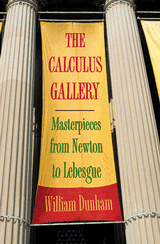The Calculus Gallery:
|

|
Mathematics is a truly evolving enterprise which fact finds expression in every facet of the body mathematics. The accumulation of knowledge is incessant: the numbers of terms, theorems, and even theories grow with every passing year. But many more things change, most noticeably the standards of the communal discourse, i.e. the manner in which mathematics is being communicated between professionals, has undergone a metamorphosis on a grandiose scale. For about two thousand years the language of mathematics was modeled after the classical Euclid's Elements. And then the most fundamental revamp of the foundations of mathematics has occurred in the last four hundred years in the wake of the emergent science of Calculus and alongside its evolution.
Have you ever tried to plough through the early Calculus texts, say, those of the founding fathers, I. Newton and G. W. Leibniz? Truly, this undertaking is not for a light hearted. Derek Whiteside, editor of Newton's mathematical papers, aptly characterized a proof that the area under the graph of
Still, there is an impelling attraction to read and learn from these great minds. Newton - along with Archimedes and Gauss - is counted among the three foremost mathematicians of all times. Leibniz, with his varied interests and far-reaching contributions, had an intellect of phenomenal breadth. Besides philosophy and mathematics, he excelled in history, jurisprudence, languages, theology, logic, and diplomacy [Dunham, p. 20].
Come The Calculus Gallery: Masterpieces from Newton to Lebesgue by William Dunham, the master storyteller. Unlike other mathematics history books (like those by, say, I. Grattan-Guinness or H. Eves) or like eclectic The Mathematical Universe and Journey Through Genius by Dunham himself, The Calculus Gallery is focused on a specific development in the history of mathematics, that of the Calculus. This allows the author to go and exploit the work of the masters in a much greater detail, on one hand, and in a more interconnected manner, on the other. Unlike source books (e.g., those by J. Fauvel and J. Grey, D. J. Struik, D. E. Smith) where a short background commentary usually precedes the texts, in The Calculus Gallery texts are woven together into Dunham's commentary and a story serving a coherent panoramic narrative of the development and the evolution of the ideas and the methods of what became a most fundamental and ground breaking branch of mathematics. The story is deliberately confined to the works of Calculus proper. Starting with the fluxions and fluents of Newton and differentials and integrals of Leibniz, it ends with the invention of Measure Theory and a revolutionary method of integration by Henri Lebesgue. The intermediate chapters cover the contributions of Jacob and Johann Benoulli, Leonhard Euler, Augustin-Louis Cauchy, G. F. B. Riemann, Joseph Liouville, Karl Weistrass, Georg Cantor, Vito Volterra, and René Baire. There are also two Interlude chapters that supply additional background information.
The book is a lucid read; explanations and commentary are lovely and clear; the selections from the prolific authors help appreciate their individual mastery and ingenuity; the masterful story line creates a coherent whole that is a pleasure to read and an asset to own. I am sure that the teachers of mathematics, especially at the Liberal Arts colleges and high schools, and the curious among their students will enjoy the book tremendously.
(For several quotes from the book see What Is Calculus?)
The Calculus Gallery: Masterpieces from Newton to Lebesgue, Princeton University Press. Softcover, 236 pp, $19.95. ISBN 0691136262.
The books mentioned
- W. Dunham,The Calculus Gallery: Masterpieces from Newton to Lebesgue, Princeton University Press, 2008
- H. Eves,Great Moments in Mathematics: Before 1650, MAA, 1983
- H. Eves,Great Moments in Mathematics: After 1650, MAA, 1983
- J. Fauvel, J. Grey, The History of Mathematics: A Reader, The Open University, 1987
- I. Grattan-Guinness, The Rainbow of Mathematics, W. W. Norton, 1997
- D. J. Struik, A Source Book In Mathematics: 1200-1800, Princeton University Press, 1990
- D. E. Smith, A Source Book in Mathematics, Dover Publications, 1959.
|Up| |Contact| |Front page| |Contents|
Copyright © 1996-2018 Alexander Bogomolny71752805
